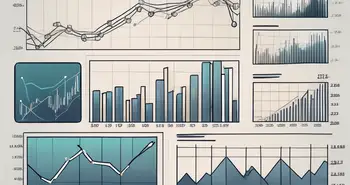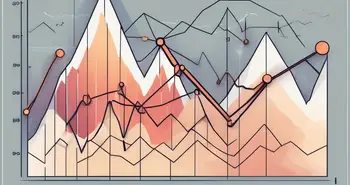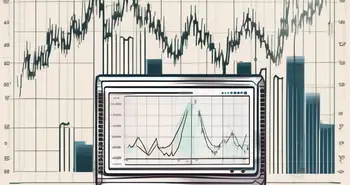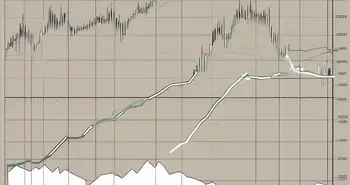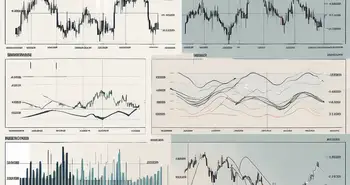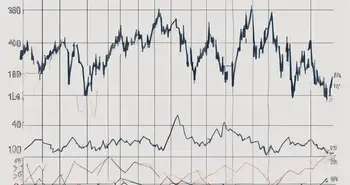Common Chart Indicators: A Complete Overview

In the world of trading, chart indicators are invaluable tools for analyzing market trends and making informed decisions. Whether you're a novice trader or an experienced investor, understanding these indicators is crucial for success. In this comprehensive overview, I'll provide you with a summary of common chart indicators, their types, interpretation techniques, and their role in trading. Let's delve into the world of chart indicators and unlock the secrets to profitable trading strategies.
Understanding Chart Indicators
Chart indicators are mathematical calculations that utilize historical price and volume data to forecast future trends. By plotting these indicators on a chart, traders can identify potential buy and sell signals, assess market momentum, and determine price volatility. The importance of chart indicators cannot be overstated, as they provide valuable insights into market behavior and help traders make informed decisions.
When it comes to analyzing market trends, chart indicators serve as valuable tools for traders. They enable us to make sense of complex price movements by identifying patterns and signals that might not be immediately apparent. By understanding and leveraging these indicators, traders can gain an edge in the market and improve their trading strategies.
The Importance of Chart Indicators
Chart indicators play a crucial role in technical analysis, which is the study of historical price and volume data to predict future price movements. Technical analysts believe that historical price patterns tend to repeat themselves, and by identifying these patterns, they can make educated guesses about future price movements.
One of the primary reasons chart indicators are important is that they help traders identify potential buy and sell signals. These signals can indicate when it may be a good time to enter or exit a trade, allowing traders to capitalize on profitable opportunities. By using indicators such as moving averages, relative strength index (RSI), or stochastic oscillators, traders can spot trends and potential reversals in the market.
Another vital aspect of chart indicators is their ability to assess market momentum. Momentum refers to the strength or weakness of a price trend. By using indicators like the moving average convergence divergence (MACD) or the average directional index (ADX), traders can gauge the momentum of a particular asset or market. This information can help traders determine whether a trend is likely to continue or if a reversal is imminent.
Furthermore, chart indicators provide insights into price volatility. Volatility refers to the degree of variation in a price over a specific period. High volatility can present both opportunities and risks for traders. By using indicators such as Bollinger Bands or Average True Range (ATR), traders can assess the level of volatility in the market and adjust their trading strategies accordingly.
Basic Concepts of Chart Indicators
Before diving into the types of chart indicators, it's essential to understand some basic concepts. First and foremost, it's important to note that chart indicators are not crystal balls. They cannot predict future price movements with absolute certainty. Instead, they provide probabilities and insights based on historical data.
Additionally, different chart indicators have different strengths and weaknesses. No single indicator can provide a complete picture of the market. Therefore, it is crucial to use a combination of indicators to conduct a comprehensive analysis. By combining indicators that complement each other, traders can increase the reliability of their trading signals and reduce the likelihood of false or misleading information.
It's also important to consider the time frame when using chart indicators. Some indicators work better on shorter time frames, such as intraday trading, while others are more suitable for longer-term analysis. Traders should choose indicators that align with their trading style and time frame to ensure accurate and relevant information.
In conclusion, chart indicators are powerful tools that can help traders analyze market trends, identify buy and sell signals, assess market momentum, and determine price volatility. However, it's crucial to understand their limitations and use them in conjunction with other forms of analysis to make informed trading decisions.
Types of Common Chart Indicators
Chart indicators come in various forms, each serving a unique purpose. Let's explore some of the most commonly used indicators:
Moving Averages
Moving averages are trend-following indicators that smooth out price data by calculating the average closing price over a specific period. They help identify the direction of the current trend and potential support and resistance levels. Traders often use moving averages to confirm trend reversals and generate trading signals.
For example, a trader may use a 50-day moving average to determine the overall trend of a stock. If the stock's price is consistently above the moving average, it suggests an uptrend. Conversely, if the price consistently falls below the moving average, it indicates a downtrend.
Additionally, moving averages can be used to identify potential support and resistance levels. When the price approaches a moving average, it may act as a support level if the price bounces off it and continues to rise. On the other hand, if the price breaks below a moving average, it may act as a resistance level, preventing further upward movement.
Relative Strength Index (RSI)
The RSI is a momentum oscillator that measures the speed and change of price movements. It provides an indication of overbought and oversold conditions, helping traders identify potential entry and exit points. The RSI is a valuable tool for assessing the strength and sustainability of a trend.
When the RSI is above 70, it suggests that the asset is overbought, meaning it may be due for a price correction or reversal. Conversely, when the RSI is below 30, it indicates that the asset is oversold, potentially signaling a buying opportunity.
Traders often use the RSI in conjunction with other technical indicators to confirm trading signals. For example, if the RSI indicates an overbought condition and a moving average crossover confirms a trend reversal, it may provide a stronger signal to sell.
Bollinger Bands
Bollinger Bands consist of a moving average and two standard deviation lines above and below it. These bands help traders identify volatility and potential price reversal points. When the price approaches the upper band, it may indicate an overbought condition, while approaching the lower band may signal an oversold condition.
One way traders use Bollinger Bands is by looking for “squeeze” patterns. A squeeze occurs when the bands narrow, indicating low volatility. Traders anticipate that this low volatility period will be followed by a significant price movement. When the bands expand again, it may signal the start of a new trend.
Additionally, Bollinger Bands can be used to identify potential support and resistance levels. If the price consistently bounces off the lower band, it may act as a support level. Conversely, if the price consistently fails to break above the upper band, it may act as a resistance level.
How to Interpret Chart Indicators
Now that we've explored the different types of chart indicators, let's discuss how to interpret them effectively:
Reading and Analyzing Moving Averages
Moving averages are versatile indicators that can be used in various ways. When the price crosses above a moving average, it may signal a bullish trend, while a crossing below may indicate a bearish trend. Traders often look for confluence between different moving averages to validate their trading decisions.
Understanding the RSI
When interpreting the RSI, traders look for overbought readings above 70, which may suggest a potential price reversal and a good time to sell. On the other hand, oversold readings below 30 may indicate a potential buying opportunity. The RSI is most effective when used in conjunction with other indicators and price analysis.
Using Bollinger Bands for Market Analysis
Bollinger Bands can help traders identify periods of consolidation and potential breakout opportunities. When the price moves beyond the upper or lower band, it may signal a strong price movement in that direction. Traders often combine Bollinger Bands with other indicators to increase the accuracy of their analysis.
The Role of Chart Indicators in Trading
Chart indicators play a crucial role in trading by providing traders with valuable insights and helping them enhance their trading strategies.
Enhancing Trading Strategies with Chart Indicators
By incorporating chart indicators into their trading strategies, traders can gain a deeper understanding of market dynamics and make more informed decisions. Indicators can help confirm trend reversals, identify potential entry and exit points, and improve risk management.
Risk Management with Chart Indicators
Chart indicators can also assist traders in managing their risk effectively. By identifying overbought and oversold conditions, traders can adjust their position sizes, set stop-loss orders, and avoid unnecessary risks. Utilizing chart indicators in risk management strategies can help traders protect their capital and minimize potential losses.
Common Mistakes When Using Chart Indicators
Although chart indicators are powerful tools, traders must be cautious not to fall into common pitfalls:
Avoiding Overreliance on a Single Indicator
Some traders make the mistake of relying solely on a single chart indicator. While indicators can provide valuable insights, using multiple indicators and conducting thorough analysis is crucial for accurate predictions and sound trading decisions.
Misinterpreting Indicator Signals
Interpreting chart indicators requires experience and skill. Novice traders often misinterpret indicator signals, leading to poor trading outcomes. It's essential to invest time in studying and understanding each indicator's mechanics to make informed decisions and avoid costly mistakes.
Now that you have a comprehensive overview of common chart indicators, take the time to explore each indicator in detail, experiment with different combinations, and develop your trading strategies. Remember, successful trading requires a deep understanding of these indicators and continuous learning to adapt to evolving market conditions.
FAQ
What are chart indicators?
Chart indicators are mathematical calculations that utilize historical price and volume data to forecast future trends. They help traders analyze market behavior and make informed trading decisions.
How do I use chart indicators effectively?
To use chart indicators effectively, it's crucial to understand their strengths, weaknesses, and interpretation techniques. Consider using a combination of indicators and conducting thorough analysis for accurate predictions.
Can I rely solely on chart indicators for trading decisions?
No, it's advisable to use chart indicators in conjunction with other technical and fundamental analysis tools. Relying solely on chart indicators may lead to incomplete analysis and poor trading outcomes.
How can chart indicators help in risk management?
Chart indicators can help in risk management by identifying overbought and oversold conditions, allowing traders to adjust their position sizes, set stop-loss orders, and avoid unnecessary risks.
Take the time to explore chart indicators, practice interpreting their signals, and continuously improve your trading strategies. With dedication and a solid understanding of these indicators, you'll be well on your way to flourishing as a successful trader.
Ready to elevate your trading game with the insights you've gained on chart indicators? Join Morpher, the revolutionary trading platform that's redefining the investment landscape. With zero fees, infinite liquidity, and the ability to trade a vast array of assets, Morpher is the perfect partner for your trading journey. Whether you're interested in fractional investing, short selling without interest fees, or leveraging up to 10x, Morpher provides a unique and innovative trading experience on the Ethereum Blockchain. Sign up now at Morpher.com and receive your free sign-up bonus to start trading the markets like never before.

Disclaimer: All investments involve risk, and the past performance of a security, industry, sector, market, financial product, trading strategy, or individual’s trading does not guarantee future results or returns. Investors are fully responsible for any investment decisions they make. Such decisions should be based solely on an evaluation of their financial circumstances, investment objectives, risk tolerance, and liquidity needs. This post does not constitute investment advice.

Painless trading for everyone
Hundreds of markets all in one place - Apple, Bitcoin, Gold, Watches, NFTs, Sneakers and so much more.

Painless trading for everyone
Hundreds of markets all in one place - Apple, Bitcoin, Gold, Watches, NFTs, Sneakers and so much more.

